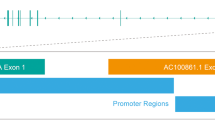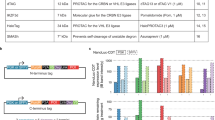Abstract
Here we describe the Achilles' Heel Method (AHM), a new function-based approach for identification of inhibitors of signaling pathways, optimized for human cells. The principle of AHM is the identification of ‘sensitizing’ cDNAs based on their decreased abundance following selection. As a proof of principle, we have employed AHM for the identification of Fas/CD95/APO-1 pathway inhibitors. HeLa cells were transfected with an antisense cDNA expression library in an episomal vector followed by selection with a suboptimal dose of the apoptotic inducer. Antisense inactivation of Fas inhibitors rendered the cells more sensitive to apoptosis resulting in their preferential death and consequent loss of their sensitizing episomes that were identified by subtraction. We show that the resulting products were enriched for sensitizing cDNAs as seven out of eight candidates tested were confirmed as inhibitors of Fas-induced killing either by transfection or by pharmacological inhibition. Furthermore, we demonstrate by multiple approaches that one candidate, NF-E2 related factor 2 (Nrf2), is an inhibitor of Fas-induced apoptosis. Inactivation of Nrf2 by antisense or by a membrane permeable dominant-negative polypeptide sensitized cells while overexpression of Nrf2 protected cells from Fas-induced apoptosis. In addition, dicumarol, an inhibitor of the phase II detoxifying enzyme NQO1, a downstream target of Nrf2, sensitized cells. Nrf2 induces the production of Glutathione (GSH) and we demonstrated that N-acetyl L-cysteine (NAC), a precursor to GSH, protected cells from Fas-mediated killing. Taken together, AHM is a powerful approach for the identification of inhibitors of a signaling pathway with a low rate of false positives that opens new avenues for function profiling of human genes and discovery of new drug targets.
This is a preview of subscription content, access via your institution
Access options
Subscribe to this journal
Receive 50 print issues and online access
$259.00 per year
only $5.18 per issue
Buy this article
- Purchase on Springer Link
- Instant access to full article PDF
Prices may be subject to local taxes which are calculated during checkout






Similar content being viewed by others
References
Asher G, Lotem J, Cohen B, Sachs L and Shaul Y . (2001). Proc. Natl. Acad. Sci. USA, 98, 1188–1193.
Ashkenazi A and Dixit VM . (1999). Curr. Opin. Cell Biol., 11, 255–260.
Begleiter A, Leith MK, Curphey TJ and Doherty GP . (1997). Oncol. Res., 9, 371–382.
Chan K and Kan YW . (1999). Proc. Natl. Acad. Sci. USA, 96, 12 731–12 736.
Cross JV, Deak JC, Rich EA, Qian Y, Lewis M, Parrott LA, Mochida K, Gustafson D, Vande Pol S and Templeton DJ . (1999). J. Biol. Chem., 274, 31 150–31 154.
De Flora S, Izzotti A, D'Agostini F and Balansky RM . (2001). Carcinogenesis, 22, 999–1013.
Deiss LP, Feinstein E, Berissi H, Cohen O and Kimchi A . (1995). Genes Dev., 9, 15–30.
Deiss LP, Galinka H, Berissi H, Cohen O and Kimchi A . (1996). EMBO J., 15, 3861–3870.
Deiss LP and Kimchi A . (1991). Science, 252, 117–120.
Hitoshi Y, Lorens J, Kitada SI, Fisher J, LaBarge M, Ring HZ, Francke U, Reed JC, Kinoshita S and Nolan GP . (1998). Immunity, 8, 461–471.
Holmstrom TH, Tran SE, Johnson VL, Ahn NG, Chow SC and Eriksson JE . (1999). Mol. Cell Biol., 19, 5991–6002.
Hosoda S, Nakamura W and Hayashi K . (1974). J. Biol. Chem., 249, 6416–6423.
Ishii T, Itoh K, Takahashi S, Sato H, Yanagawa T, Katoh Y, Bannai S and Yamamoto M . (2000). J. Biol. Chem., 275, 16 023–16 029.
Itoh K, Chiba T, Takahashi S, Ishii T, Igarashi K, Katoh Y, Oyake T, Hayashi N, Satoh K, Hatayama I, Yamamoto M and Nabeshima Y . (1997). Biochem. Biophys. Res. Commun., 236, 313–322.
Jaiswal AK . (2000). Free Radic. Biol. Med., 29, 254–262.
Joseph P, Xie T, Xu Y and Jaiswal AK . (1994). Oncol. Res., 6, 525–532.
Kazama H and Yonehara S . (2000). J. Cell Biol., 148, 557–566.
Kimchi A . (1998). Biochim. Biophys. Acta, 1377, F13–F33.
Kissil JL, Deiss LP, Bayewitch M, Raveh T, Khaspekov G and Kimchi A . (1995). J. Biol. Chem., 270, 27 932–27 936.
Ko BC, Turck CW, Lee KW, Yang Y and Chung SS . (2000). Biochem. Biophys. Res. Commun., 270, 52–61.
Krause D, Lyons A, Fennelly C and O'Connor R . (2001). J. Biol. Chem., 276, 19 244–19 252.
Levy-Strumpf N, Deiss LP, Berissi H and Kimchi A . (1997). Mol. Cell Biol., 17, 1615–1625.
Maestro R, Dei Tos AP, Hamamori Y, Krasnokutsky S, Sartorelli V, Kedes L, Doglioni C, Beach DH and Hannon GJ (1999). Genes Dev., 13, 2207–2217.
Meyer UA . (1996). J. Pharmacokinet. Biopharm., 24, 449–459.
Miyakawa H, Woo SK, Dahl SC, Handler JS and Kwon HM . (1999). Proc. Natl. Acad. Sci. USA, 96, 2538–2542.
Moi P, Chan K, Asunis I, Cao A and Kan YW . (1994). Proc. Natl. Acad. Sci. USA, 91, 9926–9930.
Moinova HR and Mulcahy RT . (1999). Biochem. Biophys. Res. Commun., 261, 661–668.
Nagata S . (1997). Cell, 88, 355–365.
Neckers L . (2002). Trends Mol. Med., 8, S55–S61.
Ohtsubo T, Kamada S, Mikami T, Murakami H and Tsuimoto Y . (1999). Cell Death Differ., 6, 865–872.
Pinkoski MJ and Green DR (1999). Cell Death Differ., 6, 1174–1181.
Richter K and Buchner J (2001). J. Cell Physiol., 188, 281–290.
Salinas AE and Wong MG . (1999). Curr. Med. Chem., 96, 279–309.
Scaffidi C, Fuda S, Srinivasan A, Friesen C, Li F, Tomaselli KJ, Debatin KM, Krammer PH and Peter ME (1998). Embo. J., 17, 1675–1687.
Schwarze SR, Ho A, Vocero-Akbani A and Dowdy SF (1999). Science, 285, 1569–1572.
Siemankowski LM, Morreale J, Butts BD and Briehl MM . (2000). Cancer Res., 60, 3638–3644.
Stark GR and Gudkov AV . (1999). Hum. Mol. Genet., 8, 1925–1938.
Tewari M, Telford WG, Miller RA and Dixit VM . (1995). J. Biol. Chem., 270, 22 705–22 708.
Venugopal R and Jaiswal AK (1996). Proc. Natl. Acad. Sci. USA, 93, 14 960–14 965.
Wasserman WW and Fahl WE . (1997). Proc. Natl. Acad. Sci. USA, 94, 5361–5366.
Whitesell L, Mimnaugh EG, De Costa B, Myers CE and Neckers LM . (1994). Proc. Natl. Acad. Sci. USA, 91, 8324–8328.
Yu R, Chen C, Mo YY, Hebbar V, Owuor ED, Tan TH and Kong AN . (2000a). J. Biol. Chem. 275, 39 907–39 913.
Yu R, Lei W, Mandlekar S, Weber M J, Der CJ, Wu J and Kong AT . (1999). J. Biol. Chem., 274, 27 545–27 552.
Yu R, Mandlekar S, Lei W, Fahl WE, Tan TH and Kong AT . (2000b). J. Biol. Chem., 275, 2332–2327.
Acknowledgements
Owing to space constrains, we were only able to cite limited number of papers; we regret not being able to acknowledge many of the important contributions to the filed. We thank Drs Igor Roninson, Robert Costa, Nissim Hay, Ruth Maya and Gerald Cohen for critical reading of the manuscript and for fruitful discussions; Dr Yuet Wai Kan for the Nrf2 clone, Dr Steven F Dowdy for the plasmids and protocols for the TAT mediated protein transduction system, Dr Vishva Dixit for the crmA clone and Croydon Fernandes for technical help. This work was supported by a grant from Quark Biotech Inc.
Author information
Authors and Affiliations
Corresponding author
Rights and permissions
About this article
Cite this article
Kotlo, K., Yehiely, F., Efimova, E. et al. Nrf2 is an inhibitor of the Fas pathway as identified by Achilles' Heel Method, a new function-based approach to gene identification in human cells. Oncogene 22, 797–806 (2003). https://doi.org/10.1038/sj.onc.1206077
Received:
Revised:
Accepted:
Published:
Issue Date:
DOI: https://doi.org/10.1038/sj.onc.1206077
Keywords
This article is cited by
-
Hederagenin Suppresses Inflammation and Cartilage Degradation to Ameliorate the Progression of Osteoarthritis: An In vivo and In vitro Study
Inflammation (2023)
-
Involvement of redox signalling in tumour cell dormancy and metastasis
Cancer and Metastasis Reviews (2023)
-
Ascorbyl stearate stimulates cell death by oxidative stress-mediated apoptosis and autophagy in HeLa cervical cancer cell line in vitro
3 Biotech (2019)
-
Boron Affects the Development of the Kidney Through Modulation of Apoptosis, Antioxidant Capacity, and Nrf2 Pathway in the African Ostrich Chicks
Biological Trace Element Research (2018)
-
Silencing of Hsp90 Chaperone Expression Protects Against 6-Hydroxydopamine Toxicity in PC12 Cells
Journal of Molecular Neuroscience (2014)



